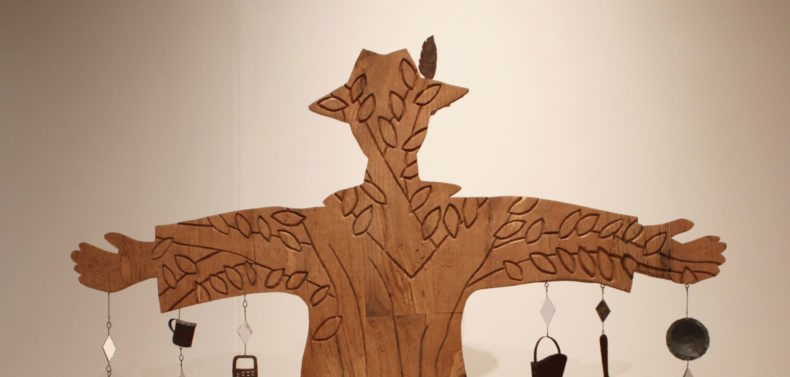For over a century, a willow oak tree graced the lawn of the historic Ware-Lyndon House, towering above the garden as a loyal sentinel. Ever since the Lyndon House Arts Center’s establishment in 1973, the magnificent plant has served as a muse and model for artists practicing their crafts.
After reaching the end of its estimated 150-year lifespan—120, if you’re counting by its rings—the tree was removed from the property in 2016. Fittingly, the “Willow Oak Tree Exhibition” now pays its respects through the talents of 14 local artists who were tasked with the challenge of repurposing reclaimed wood from the tree into works that reflect the tree’s connection to the arts center and larger arts community.
“Wood is beautiful. It presents itself in different colors, grain patterns and character generating ‘flaws,’” says guest curator Abraham Tesser. “Wood is hard enough to stand up for centuries, but plastic enough to be easily shaped with hand tools and affordable machines. It can be brought to a silky smooth finish and has a warmth that few other materials manifest. I love the feel of it and the smell of it… shalI I go on?”
Regrettably, the wood had not been stored properly; the logs were left uncovered in a field for several years, and much of what was initially harvested was poached. Damaged by weather and fungi, the wood was considerably rotten and unusable for many traditional applications. Though a few invited artists chose to step away at that revelation, others reframed the damage as flourishes of character, texture and color that could be worked around or incorporated into their designs.

What distinguishes this exhibition from others similarly spotlighting woodworkers is how diverse the artists’ approaches are for transforming compromised material. On one side of the spectrum, there’s Jim Talley, a woodturner who found the most perfect 2-inch cubes possible to create a set of miniature vessels turned on the scale of 1/12 inches. Representing the other side of the spectrum, Martijn van Wagtendonk simply converted his wood into charcoal that he then used to draw a wall-spanning mural depicting the willow oak tree. Most fall somewhere in between, responding to natural blemishes and finding solutions to preserve the integrity of the wood however they can. Richard Shrader’s sleek “Willow Oak Coffee Table,” for example, uses an epoxy finish to stabilize the book match table top, which is supported by metal oak trees for legs.
While the physical quality (and resulting limitations) of the wood was ultimately the most significant influence over each artist’s design, the artists also demonstrate a wide range of ideas for how to visually convey meaning through their work. By memorializing the willow oak with its own wood, the willow tree effectively survives and lives on—shifting from organism to object, yet remaining present in the everyday.
Holding a deep respect for the trees, some artists present works that feel more spiritual in nature. “Duane Paxson simply assumes that the tree we worked on should be venerated, and he has built a reliquary to do so,” says Tesser. Patterning his design after the ancient tradition of containers used to display and protect the sacred remains of a holy person, Paxson’s hanging sculpture, “Willow Tree Reliquary,” encases an unaltered slab of wood within an ornate welded steel cocoon. Teaser says, “Larry Millard’s piece with the gilded interior makes us very much aware of the tree’s inner glow.” Millard’s sculpture, “ROUGH,” invites viewers to search for the inherent beauty within; rugged and flawed on the outside, the log swings open to reveal a golden center.
Other artists reflect on the passage of time and allude to how the willow oak acted as a constant throughout the decades. Tad Gloeckler’s “Tribute to Willow Oak Tree (circa 1900–2016)” is an intricate alternative architectural project that maps a historical timeline using miniature artifacts and fictional narratives of six generations of families who interacted with the tree. Jim Underwood’s “Turning Time” is a classic, utilitarian and beautifully turned hourglass. Reid McCallister’s wall-bound assemblage, “Time Machine,” juxtaposes various artifacts to symbolize the tree’s lifetime, which the artist points out was marked by “the first electric lights and trolley, two World Wars, the Voting Rights Act, the establishment of Lay Park and the formation of the Lyndon House Arts Center.”
The “Willow Oak Tree Exhibit,” which is accompanied by a publication full of interviews and biographical details, will remain on view through Nov. 18. While at the arts center, be sure to also visit Shannon Williams’ portrait series of the willow oak photographed throughout the seasons. As part of 3Thurs, the gallery will host a virtual gallery talk with artists Cal Logue, McCallister, Leonard Piha and Shrader on Oct. 21 at 6 p.m. Tesser will lead a virtual Willow Oak Tree Symposium on Oct. 30 from 1–3:30 p.m. during which Peter Bull will discuss timber preparation, Gloeckler will explore narrative in sculpture, and Millard will speak on the creation and consumption of public art.
Like what you just read? Support Flagpole by making a donation today. Every dollar you give helps fund our ongoing mission to provide Athens with quality, independent journalism.










